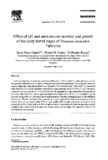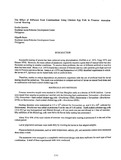Effect of pH and ammonia on survival and growth of the early larval stages of Penaeus monodon Fabricius

Tingnan/
Request this document
Petsa
1994Page views
130Metadata
Ipakita ang buong tala ng itemCited times in Scopus
Share
Abstract
Lethal toxicity tests of ammonia at different pH levels (7, 7.5, 8, and 8.5) and its effect on survival and growth of the early larval stages of Penaeus monodon were determined. An increase in ammonia toxicity when the water pH increased was revealed in 96 h toxicity tests. Estimated LT50 decreased from 101.09 to 25.16 h for protozoea exposed to 8 ppm ammonia, from 115.79 to 11.26 h for mysis exposed to 24 ppm, and from 51.41 to 22.58 h for PL exposed to 52 ppm ammonia with increase in pH levels. The effect of 3 and 6 ppm ammonia levels at pH levels of 7.0, 7.5, 8.0 and 8.5 on the survival and growth of P. monodon larvae and postlarvae was also investigated in a 16-day sublethal toxicity test. Results indicated that ammonia at 3 and 6 ppm affects both survival and growth of shrimp. Survival was decreased by 27% in 3 ppm and by 48% in 6 ppm ammonia, while growth was reduced by 4.4% in 3 ppm and by 6.5% in 6 ppm ammonia. Increasing pH of the rearing water resulted in significantly lower survival in protozoea, mysis, and postlarval stages. No interactive effect of pH and ammonia was detected.
Suggested Citation
Noor-Hamid, S., Fortes, R. D., & Parado-Estepa, F. (1994). Effect of pH and ammonia on survival and growth of the early larval stages of Penaeus monodon Fabricius. Aquaculture , 125(1-2), 67-72. https://doi.org/10.1016/0044-8486(94)90283-6
Paksa
Taxonomic term
Mga koleksyon
- AQD Journal Articles [1215]
Related items
Showing items related by title, author, creator and subject.
-
Osmoregulation in Penaeus monodon: Effects of molting and external salinity
Ferraris, Ronaldo P.; Parado-Estepa, Fe D.; de Jesus, Evelyn G.; Ladja, Jocelyn M. (Asian Fisheries Society, 1986)The effect of molting on osmotic, chloride, calcium and total protein concentrations in the hemolymph of the shrimp Penaeus monodon was investigated. Regardless of medium salinity, tissue water as well as osmotic and ... -
The effect of different feed combinations using chicken egg yolk in Penaeus monodon larval rearing
Quinitio, Emilia; Reyes, Edgardo (Brigham Young University Hawaii Campus, 1983) -
Fate and effects of water-borne heavy metals in Penaeus monodon
Vogt, Gunter; Quinitio, Emilia T. (European Aquaculture Society, 1991)Heavy metals impair the aquaculture of shrimps and the quality of shrimp products. Some heavy metals occur in high amounts particularly in the hepatopancreas and the antennal gland (Gibson and Barker, 1979). This study was ...





